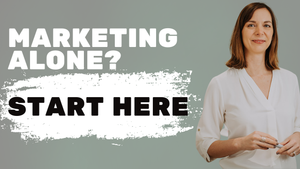Biotech companies and service providers like CROs, CDMOs, and consultants operate in different orbits. One side is building the next breakthrough drug. The other is selling precision, speed, and reliability to help those breakthroughs reach the clinic or the market.
Because their business models are so different, their marketing strategies have evolved separately — almost in silos. Biotechs often prioritize visionary storytelling and investor buzz, while CROs focus on lead generation, clear positioning, and long-term client relationships.
But what if these two worlds took the time to learn from each other?
If drug developers borrowed some of the tactical rigor of CRO marketing — and if service providers infused more emotion and narrative into their brand — both sides could sharpen their communication, accelerate growth, and build stronger reputations in the industry.
This article explores what each side does well, what the other often overlooks, and how companies can start bridging that gap today.
Two worlds, two playbooks
Let’s start with the basics: biotechs and service providers play fundamentally different games.
Biotechs are typically funded by venture capital and public markets. Their audience includes investors, scientific peers, patients, regulators and pharma partners. Marketing here is often about building trust, momentum, and excitement around a pipeline that may be years from market. The goal is rarely to sell something. Instead, biotechs are looking for two things: cash and licensing deals.
Service providers like CROs and CDMOs, on the other hand, run on client contracts and revenue. Their marketing is more direct: find leads, nurture relationships, and convert prospects into paying customers. The emphasis is on precision, reliability, and clarity. The better they are at those things, the more chances they will sell their product or services.
Because of these differences, their marketing cultures have diverged:

Both models make sense for their respective business goals, but they’re also limiting, which is why a smart blend could be so powerful.
What drug developers can learn from CROs/service providers
Many early-stage biotechs treat marketing as a secondary concern. The science is the product, and the assumption is that good data speaks for itself. But in today’s noisy landscape, that's not enough.
Service providers — who sell services in competitive, commoditized markets — have had to master tactical marketing to survive. Here’s what biotechs could borrow from their playbook:
1. Direct-response discipline
CROs and CDMOs are typically strong in foundational digital marketing: SEO, paid ads, lead magnets, email nurture sequences, LinkedIn outreach, and CRM tracking. Why? Because these tactics directly feed their revenue pipeline.
Biotechs can apply similar strategies — not just for customer acquisition, but to attract investors, partners, trial participants, and even talent. A biotech landing page optimized for investor interest, with a compelling email follow-up sequence, is still a rarity. But it shouldn’t be.
2. Clearer positioning
Service providers live and die by how clearly they explain what they do. Because buyers often compare multiple vendors, CROs must differentiate with precise messaging: “We make your clinical trial 72.9% faster,” or “We sequence your plasmid in 24 hours.”
Biotechs, by contrast, often get lost in scientific jargon or vague promises. Descriptions like “We’re leveraging synthetic biology to unlock cellular potential” sound impressive, but say little. CRO-style clarity — what you do, for whom, and why you’re better — would make biotech messaging much more accessible and convincing.
3. Customer-centric language
Because CROs need to convert prospects, they’re forced to write in terms of customer benefits. Their language tends to be practical: faster timelines, lower costs, fewer delays, easier compliance.
Biotechs, especially in early stages, often focus inward — describing mechanisms of action, pathways, and preclinical results. There’s value in scientific credibility, of course, but messaging should also address the hopes and needs of the audience. What impact will your therapy have on patients? Why should an investor believe in your team? CROs have learned to communicate in human terms and biotechs should, too.
4. Sales and funnel thinking
Service providers often have structured sales processes: marketing generates leads, sales qualify and convert them, and CRM systems track every step. Metrics matter as well: open rates, pipeline value, time-to-close.
Biotechs rarely operate with this kind of funnel logic. But they should. Whether you're courting investors, attracting pharma partners, or enrolling in clinical trials, thinking in terms of stages and conversion rates can help identify where communication is weak and how to fix it.
5. Website and conversion optimization
Visit a CRO or CDMO website, and you’ll often find clear calls to action: “Talk to an expert,” “Download the brochure,” “Book a meeting.” These are tools to move people down the funnel.
By contrast, many biotech websites are built like scientific posters: interesting, but passive. There's rarely a next step. By borrowing CRO tactics — forms, calls to action, gated content — biotechs could turn casual visitors into valuable contacts, whether they’re potential partners, funders, or hires.
What service providers can learn from drug developers
While CROs often win on tactical execution, their marketing can feel sterile. It’s typically benefit-driven but lacks emotion, story, or vision. Biotechs, by contrast, are better at selling a narrative and that narrative often fuels stronger reputations and engagement.
Here’s what CROs and other service providers can learn from drug developers:
1. Thought leadership and storytelling
Biotechs often lead with bold visions: curing cancer, reversing aging, or transforming drug development. They know how to craft a story around the science, the mission, or the founding team.
CROs rarely do this. Their content often consists of service lists, white papers, and trade show updates. But storytelling could help them stand out: How was the company founded? What problem are they solving differently? What trends are they seeing in the industry? What’s their vision for the future of drug development?
CROs could dramatically elevate their visibility and appeal by sharing bold perspectives, founder interviews, or insights into their clients’ success stories.
2. Media and PR savviness
Most biotechs understand the value of media visibility. They work with PR firms, pitch trade publications, issue press releases, and speak at conferences, even in preclinical stages. These efforts build credibility over time and help them attract investors, talent, and partnerships.
Many service providers, especially smaller ones, don’t do this. Yet there’s huge value in being featured in industry media or speaking at respected events. You may not need investor attention but prospective clients do notice which names show up again and again.
A CRO with a strong presence in trade press and on LinkedIn builds trust by association and shortens sales cycles in the process.
3. Emotional branding
Biotechs sell hope: the promise of a cure, a breakthrough, a better future. Their branding — when done well — reflects that.
In contrast, most CROs look and feel like they were branded in 2010: stock imagery, corporate blue palettes, and uninspired slogans like “Your Trusted Clinical Partner.”
But emotion drives decisions, even in B2B. A CDMO helping produce vaccines can lean into that mission. A tech-enabled CRO improving trial access can emphasize the human outcome. Branding doesn’t have to be flashy, but it should aspire to something bigger.
4. Founder visibility and personal brand
Biotech CEOs are often visible on LinkedIn, in interviews, or on stage at conferences. They embody the company’s mission and help build trust through their personal voice.
Most CRO founders or executives stay behind the scenes, yet their insights and experiences are often rich, relatable, and persuasive. When founders share ideas publicly, it not only humanizes the brand but also signals leadership in the field. A visible founder can be a growth asset, not a distraction.
5. Narrative-led pitch
Biotechs are forced to pitch — to VCs, partners, journalists, and future collaborators. This pressure creates a culture of tight storytelling, pitch decks, and messaging refinement.
CROs and CDMOs often approach growth through operational expansion — more geographies, more services — but they could learn from biotech pitch discipline. For example: if you're launching a new offering or entering a new vertical, do you have a strong narrative behind it? Have you crafted a story that resonates beyond features and specs?
Even if you’re not raising money, you're still “selling a story” and the better you package that story, the faster people buy in.
The future belongs to the hybrids
The smartest companies in life sciences marketing today are those who mix tactics from both sides.
It’s CROs that are adopting more founder-led storytelling, publishing opinion pieces, and investing in media presence. It’s also biotechs that are launching newsletters, optimizing LinkedIn strategy, and treating investors more like customers to be nurtured.
This hybrid approach reflects a deeper truth: even in a complex industry like biotech, communication is still about humans. Humans who make decisions, who seek clarity, who are moved by stories and driven by outcomes.
Marketing doesn’t need to follow rigid templates based on company type. It should follow strategy. What are your goals? Who do you need to reach? What action do you want them to take? And how can you communicate that with clarity, conviction, and consistency?
Whether you're developing a therapeutic or offering a platform to support one, you’re ultimately in the business of trust, and good marketing is how you earn it.
Biotech marketers and service providers each bring different strengths to the table. Instead of treating those differences as fixed, treat them as sources of inspiration.
- If you’re a biotech, ask yourself: are we nurturing our audiences like a CRO would? Are we being clear enough? Are we optimizing for action — not just admiration?
- If you’re a service provider, ask: are we telling a story that anyone would remember? Are we speaking like humans, not vendors? Are we building a brand that people want to follow, not just buy from?
To make it short: borrow boldly and mix strategically. You’ll find that your next marketing breakthrough might not come from your side of the fence, but from your neighbors.





